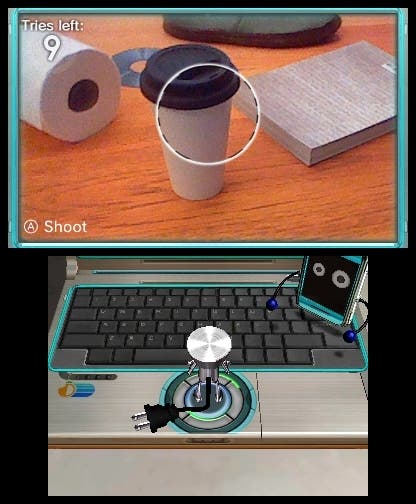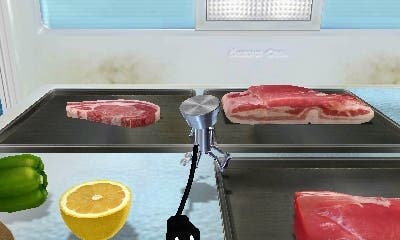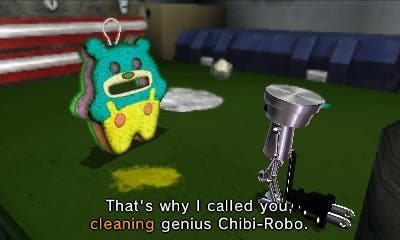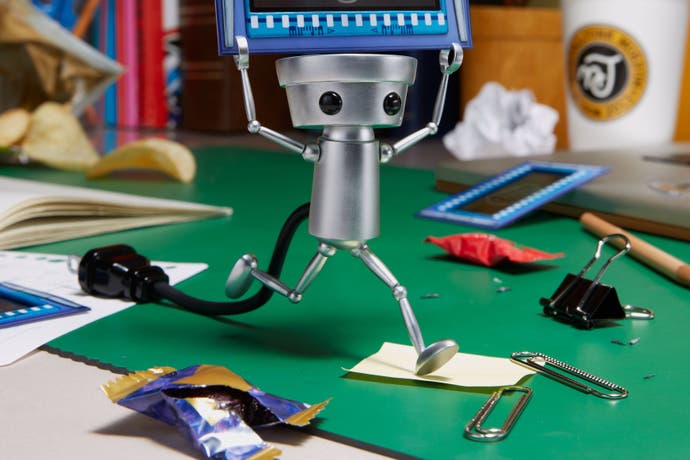Chibi-Robo! Let's Go, Photo! review
All work and no play.
The enthusiastically titled Chibi-Robo! Let's Go, Photo! is a game about taking pictures of everyday objects. It's also a game about housework and about guessing games, identifying onions and shooting balloons. It's about a lot of things - all of them very quirky in that unmistakable Japanese style - but for all its whimsy, it's also deathly dull.
If you're not familiar with Chibi-Robo, don't worry. The miniature tin man with a burning desire to help people first appeared on the GameCube in 2006 and then in a follow-up game on the DS in 2007. Both games were predictably obscure in Europe and a third title never even made it out of Japan.
So this is a fresh start, of sorts: a reboot that picks up some of the lingering gameplay threads from the earlier titles - odd little exploration adventures in domestic settings where your goal was to cheer up the people around you - then tangles them up in a knot of shallow, repetitive mini-games that are neither fun nor necessary.
The concept this time is that Chibi-Robo lives in a museum dedicated to "NostalJunk" from the past. This is the game's clunky and rather insulting term for, basically, all the crap you have in your real-life house. The curator of the museum and his talking cellphone assistant Telly task Robo with snapping photos of these objects on special "silhouette film" and then journeying into the past to retrieve them as exhibits.

It's a bizarre set-up, even by Chibi-Robo standards. While you never see the outside of the museum, you can't help feeling the game takes place in some dystopian future where people, presumably shell-shocked by some cataclysmic plague or war, need to be reminded of what eggs and cups and toilet rolls were like.
Before you can enrich the lives of the unseen eggless, cupless, dirty-bottomed masses, however, you must first buy the film needed to snap the photos to grab the NostalJunk objects. To do this, you have to earn Happy Points by undertaking jobs for various eccentric characters.
There's what appears to be a homosexual partnership of ketchup and mustard bottles - and they say Nintendo doesn't do diversity - who send you into their fridge to retrieve ingredients for their recipes. Sometimes it's hilariously easy, such as locating half a lemon. At other times, it verges on the esoteric. Could you identify pork belly amongst an array of rendered cuts of meat?
There's a toy robot who wants you to estimate lengths using a tape measure. A blob of plasticine that apparently doubles as a child minder needs you to play hide and seek with a gaggle of tiny robots. Manga-styled avian superhero Drake Redcrest asks you to shoot balloons and other targets. A lion statue in the garden needs you to get rid of polluting beasties. And so on.
Each job completed earns you Happy Points, depending on how well you did. If you need more and there are no new jobs in your inbox, you can still earn points by returning to each location for a general spring clean. Collecting rubbish (which is apparently different to the NostalJunk rubbish you collect elsewhere) and vacuuming up suspicious piles of white powder will net you a small but useful top-up of Happy Points. Provided, that is, you don't run out of energy first.

Yes, Chibi-Robo must be constantly recharged, lest he run out of Watts. You do this by picking up the plug that trails behind him and sticking it into a socket in the hub area or, very rarely, finding a battery while cleaning up. Run out of power at any point and you're dumped back to the curator's office, losing whatever you'd collected.
It's a curious mechanic; it's carried over from the previous games, but in the fragmented world of Let's Go, Photo! it feels more like the depleting energy mechanic of a free-to-play game. There's no reason for it other than to inconvenience the player, and since you start the game with just 50 Watts - which are used up even when walking around, and deplete rapidly when cleaning - it means progress is portioned out into short, unsatisfying sorties.
It's all in service of the game's photography, but this too feels incomplete and ill-conceived. You choose a "silhouette film" from a catalogue, which offers the outline of an object you're expected to photograph using the 3DS camera. Line up the outline, snap the photo and you get an accuracy rating for how well it matches. Anything less than 60% and you need to take it again. Fail nine times and you've wasted the film and must buy another. Get anywhere between 60% and 99% and you have the option of returning to the past to retrieve the object, which is cut out from the real world backdrop in some genuinely charming animations.

There's a random chance, however, that upon returning to the office, the object will disappear and be replaced with a jigsaw piece. That means it's a NostalDud, and you'll have to buy another film and start over. Only by getting 100% accuracy can you ensure that your object will be retrieved safely.
Unfortunately, the mechanism by which this accuracy is measured proves hopelessly flaky. You'll achieve 100% on objects that clearly don't align properly with the silhouette. Then you'll get 87% on a different photo that looks to be a perfect match. That's when the photo actually works. The 3DS camera is a runt of a thing, particularly poor in low light, and often you'll find that it's the environment and lens that are causing the problem, not your ability to line up shapes.
Even then, the game throws some weird curveballs. You don't know what each shape is supposed to represent until you've got a successful photo. These are usually pretty obvious, but some cultural quirks arise. One of the first films you get shows a square with two dots. I ended up taking a photo of a CD case, but it turns out it was supposed to be a plug socket. UK sockets having different pins meant that was never going to work. Similarly, for an oval-shaped film I ended up snapping a picture of a Weetabix; turns out I was supposed to be looking for sushi.

As the films become more specific and detailed, it gets harder to find objects that match. There's one of a milk carton, but the old style with a fold-out flap instead of a plastic spout. Even just lining up a T-shirt or tote bag is a problem if the real life item has proportions that are different to the game's template. When you don't have the object in question you'll find that using Google image search is a reliable workaround that can easily become a habit. And when your game's core mechanic is something the player is both forced and compelled to cheat their way past, it suggests a deep-seated design issue has not been addressed.
Before long, you start to question the amount of effort you need to put into a game that never really seems to be leading anywhere. The story babbles along sweetly enough, but it's never so gripping that you'll be compelled to sink hours into grinding Happy Points and seeking out objects to match outlines.
Tonally and aesthetically, Let's Go Photo! has a lot in common with the likes of Katamari Damacy, Noby Noby Boy and Parappa the Rapper - odd little games that also arguably have no real point. The difference is that rolling a katamari around, stretching Noby or bopping along to Chop Chop Master Onion are entertaining in their own right. In those cult classics, the game is fun and the fun is the game.
Chibi-Robo simply isn't much fun. The mini-games are tepid and even downright dull. The cleaning and exploration are fiddly and limited. The photography is glitchy and lacks direction. The game's spasmodic pace is worsened by constant dialogue scenes that must be tapped through, one line at a time. All these disparate parts fail to cohere into a gameplay experience worthy of the whimsical world they inhabit, and the result is a game that is never as engaging as it appears to be. This is one robot who maybe should have been left to gather dust rather than vacuum it up.

